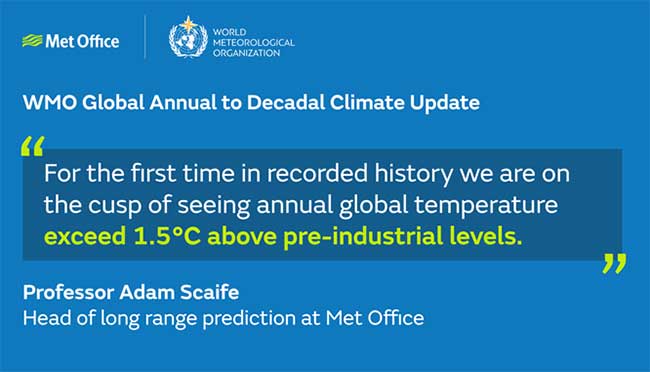Date : 05/06/2023
Relevance: GS Paper 3:Environment
Key Words: WMO, El Nino/Southern Oscillation, Sahel Region, Global Mean near surface temperature
Context–
- Recently, the World Meteorological Organization (WMO) issued the Global Annual to Decadal Climate Update.
- The Global Annual to Decadal Climate Update is issued annually by the World Meteorological Organization (WMO).
- It provides a synthesis of the global annual to decadal predictions produced by the WMO designated Global Producing Centres and other contributing centres for the period 2023-2027.
About Global Annual to Decadal Climate Update–
- It is produced annually in May and summarizes the predicted future of the global climate over the next year and the next five years.
- The focus is on climate indices such as global mean near-surface temperature, Atlantic multidecadal variability, and the El Niño/Southern Oscillation, as well as regional indices and annual and multi-year seasonal means of near-surface temperature, mean sea-level pressure, and precipitation.
Key Findings–
- Global temperatures are likely to surge to record levels in the next five years, fuelled by heat-trapping greenhouse gases and a naturally occurring El Niño event.
- The annual mean global near-surface temperature for each year between 2023 and 2027 is predicted to be between 1.1°C and 1.8°C higher than the 1850-1900 average.
- This is used as a baseline because it was before the emission of greenhouse gases from human and industrial activities.
- There is a 66% chance that the annual average near-surface global temperature between 2023 and 2027 will be more than 1.5°C above pre-industrial levels for at least one year.
- There is a 98% chance that at least one of the next five years, and the five-year period as a whole, will be the warmest on record.
- Arctic warming is disproportionately high.
- Compared to the 1991-2020 average, the temperature anomaly is predicted to be more than three times as large as the global mean anomaly when averaged over the next five northern hemisphere extended winters.
- Predicted precipitation patterns for the May to September 2023-2027 average, compared to the 1991-2020 average, suggest increased rainfall in the Sahel, northern Europe, Alaska, and northern Siberia, and reduced rainfall for this season over the Amazon and parts of Australia.
Implications–
- A warming El Niño is expected to develop in the coming months and this will combine with human-induced climate change to push global temperatures into uncharted territory.
- In addition to increasing global temperatures, human-induced greenhouse gases are leading to more ocean heating and acidification, sea ice and glacier melt, sea level rise, and more extreme weather.
- This will have far-reaching repercussions for health, food security, water management, and the environment.
Do you Know?
- The 2015 Paris Agreement is a legally binding international climate treaty, approved by world leaders attending the Climate Conference, COP21. It was adopted by 196 countries on December 12, 2015, and entered into force on November 4, 2016.
- The Paris Agreement’s main goal is to limit global warming by keeping average global temperatures “well below two, preferably to 1.5 degrees Celsius”, in comparison with pre-industrial levels.
- The Intergovernmental Panel on Climate Change says that climate-related risks for natural and human systems are higher for global warming of 1.5 °C than at present but lower than at 2 °C.
Suggestions and Way Ahead–
- This report does not mean that we will permanently exceed the 1.5C specified in the Paris Agreement, which refers to long-term warming over many years.
- However, WMO is sounding the alarm that we will breach the 1.5C level on a temporary basis with increasing frequency.
- There is a need to strengthen weather and climate services to support climate change adaptation.
- The focus should be on the ongoing Early Warnings for All initiative to protect people from increasingly extreme weather.
Probable Question for Mains exam-
- Question 1: Analyze the relation between global heating and climatic turbulence especially in the light of recently released 'Global Annual to decadal climate update' released by WMO. Also suggest the way forward to tackle it. (15 Marks,250 Marks)
- Question 2: Discuss the significance of the Paris Agreement's goal to limit global warming to "well below two, preferably to 1.5 degrees Celsius" in the context of the findings presented in the Global Annual to Decadal Climate Update. Assess the challenges and suggest measures to strengthen climate change adaptation efforts in order to mitigate the impacts of increasing temperatures. (20 marks, 350 words)
Source: The Hindu








